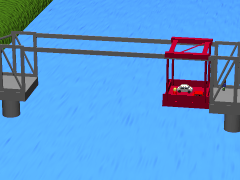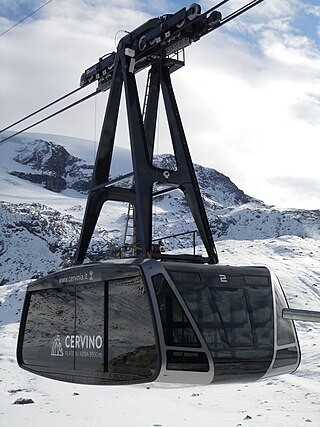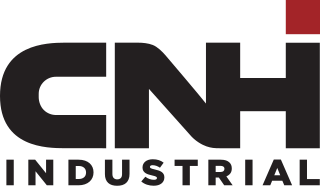
Civil engineering is a professional engineering discipline that deals with the design, construction, and maintenance of the physical and naturally built environment, including public works such as roads, bridges, canals, dams, airports, sewage systems, pipelines, structural components of buildings, and railways.

A transporter bridge, also known as a ferry bridge or aerial transfer bridge, is a type of movable bridge that carries a segment of roadway across a river. The gondola is slung from a tall span by wires or a metal frame. The design has been used to cross navigable rivers or other bodies of water, where there is a requirement for ship traffic to be able to pass. This has been a rare type of bridge, with fewer than two dozen built. There are just twelve that continue to be used today, including one converted into a lift bridge and one designed as, but not yet operating as, a transporter bridge.
In engineering, a factor of safety (FoS), also known as safety factor (SF), expresses how much stronger a system is than it needs to be for an intended load. Safety factors are often calculated using detailed analysis because comprehensive testing is impractical on many projects, such as bridges and buildings, but the structure's ability to carry a load must be determined to a reasonable accuracy.

An aisle is a linear space for walking with rows of non-walking spaces on both sides. Aisles with seating on both sides can be seen in airplanes, in buildings such as churches, cathedrals, synagogues, meeting halls, parliaments, courtrooms, theatres, and in long passenger vehicles. An aisle floor may be level or, as in theatres, sloping upward from a stage.

A detachable chairlift or high-speed chairlift is a type of passenger aerial lift, which, like a fixed-grip chairlift, consists of numerous chairs attached to a constantly moving wire rope that is strung between two terminals over intermediate towers. They are now commonplace at all but the smallest of ski resorts. Some are installed at tourist attractions as well as for urban transportation.

An aerial lift, also known as a cable car or ropeway, is a means of cable transport in which cabins, cars, gondolas, or open chairs are hauled above the ground by means of one or more cables. Aerial lift systems are frequently employed in a mountainous territory where roads are relatively difficult to build and use, and have seen extensive use in mining. Aerial lift systems are relatively easy to move and have been used to cross rivers and ravines. In more recent times, the cost-effectiveness and flexibility of aerial lifts have seen an increase of gondola lift being integrated into urban public transport systems.

Doppelmayr USA, Inc is an aerial lift manufacturer based in Salt Lake City, Utah, and a subsidiary of the worldwide Doppelmayr Garaventa Group. The United States company was formed in 2002 after the merger of Garaventa of Goldau, Switzerland, and Doppelmayr of Wolfurt, Austria. Between 2002 and 2010, the company was named Doppelmayr CTEC. From 2011 the company has operated using the Doppelmayr brand name, in common with most other Doppelmayr Garaventa Group subsidiaries.

A hopper car (US) or hopper wagon (UIC) is a type of railroad freight car used to transport loose bulk commodities such as coal, ore, grain, and track ballast. Two main types of hopper car exist: covered hopper cars, which are equipped with a roof, and open hopper cars, which do not have a roof.

In North American railroad terminology, a gondola is an open-topped rail vehicle used for transporting loose bulk materials. Because of their low side walls, gondolas are also suitable for the carriage of such high-density cargos as steel plates or coils, or of bulky items such as prefabricated sections of rail track. Gondolas are distinct from hopper cars in that they do not have doors on their floor to empty cargo.

A rotary car dumper or wagon tippler (UK) is a mechanism used for unloading certain railroad cars such as hopper cars, gondolas or mine cars. It holds the rail car to a section of track and then rotates the track and car together to dump out the contents. Used with gondola cars, it is making open hopper cars obsolete. Because hopper cars require sloped chutes in order to direct the contents to the bottom dump doors (hatches) for unloading, gondola cars allow cars to be lower, thus lowering their center of gravity, while carrying the same gross rail load. Cars are equipped with rotary couplers to allow dumping them while they are still coupled; a "Double Rotary" gondola or hopper has rotary couplers on both ends to allow it to be unloaded while it remains coupled to stationary cars at each end.
Supply-chain optimization (SCO) aims to ensure the optimal operation of a manufacturing and distribution supply chain. This includes the optimal placement of inventory within the supply chain, minimizing operating costs including manufacturing costs, transportation costs, and distribution costs. Optimization often involves the application of mathematical modelling techniques using computer software. It is often considered to be part of supply chain engineering, although the latter is mainly focused on mathematical modelling approaches, whereas supply chain optimization can also be undertaken using qualitative, management based approaches.

The Grand Canal Shoppes is an upscale shopping mall inside the Venetian and Palazzo resorts on the Las Vegas Strip in Paradise, Nevada, United States.

In retail marketing, an endcap or end cap is a display for a product placed at the end of an aisle. It is perceived to give a brand a competitive advantage. It is often available for lease to a manufacturer in a retail environment. Products placed on an endcap for sale will sell at a much faster pace than products not on the endcap. The display of products on the endcap is sometimes also called a feature.

Open wagons form a large group of railway goods wagons designed primarily for the transportation of bulk goods that are not moisture-retentive and can usually be tipped, dumped or shovelled. The International Union of Railways (UIC) distinguishes between ordinary wagons and special wagons (F/6). Open wagons often form a significant part of a railway company's goods wagon fleet; for example, forming just under 40% of the Deutsche Bahn's total goods wagon stock in Germany.

A dedicated outdoor air system (DOAS) is a type of heating, ventilation and air-conditioning (HVAC) system that consists of two parallel systems: a dedicated system for delivering outdoor air ventilation that handles both the latent and sensible loads of conditioning the ventilation air, and a parallel system to handle the loads generated by indoor/process sources and those that pass through the building enclosure.

A shelf is a flat, horizontal plane used for items that are displayed or stored in a home, business, store, or elsewhere. It is raised off the floor and often anchored to a wall, supported on its shorter length sides by brackets, or otherwise anchored to cabinetry by brackets, dowels, screws, or nails. It can also be held up by columns or pillars. A shelf is also known as a counter, ledge, mantel, or rack. Tables designed to be placed against a wall, possibly mounted, are known as console tables, and are similar to individual shelves.

A gondola is a freestanding fixture used by retailers to display merchandise. Gondolas typically consist of a flat base and a vertical component featuring notches, pegboards, or slatwalls. The vertical piece can be fitted with shelves, hooks, or other displays. Gondolas placed end-to-end can form rows of shelving, while stand-alone gondolas tend to be used for special themed displays. A gondola placed perpendicular to the end of a row of other gondolas can be used as an endcap. In Europe, gondola normally refers to double-sided shop shelving. In clothing stores, merchandising is carried out using 3-specialized shelving for clothing, and makes it possible to highlight specific products to increase the average basket at the checkout.
Robustness is the ability of a structure to withstand events like fire, explosions, impact or the consequences of human error, without being damaged to an extent disproportionate to the original cause – as defined in EN 1991-1-7 of the Accidental Actions Eurocode.

CNH Industrial N.V. is an Italian-American multinational corporation with global headquarters in Basildon, United Kingdom, but controlled and mostly owned by the multinational investment company Exor, which in turn is controlled by the Agnelli family. The company is listed on the New York Stock Exchange. The company is incorporated in the Netherlands. The seat of the company is in Amsterdam, Netherlands, with a principal office in London, England.

In library science and architecture, a stack or bookstack is a book storage area, as opposed to a reading area. More specifically, this term refers to a narrow-aisled, multilevel system of iron or steel shelving that evolved in the 19th century to meet increasing demands for storage space. An "open-stack" library allows its patrons to enter the stacks to browse for themselves; "closed stacks" means library staff retrieve books for patrons on request.
















